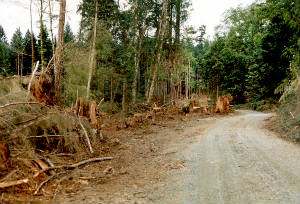
BC has laws governing mining roads, other laws governing forestry roads and still other laws governing oil and gas roads. And historically there’s been no real coordination between the companies building these different roads. As a result, BC has an estimated 400,000 to 550,000 kilometres of unpaved resource roads (the government itself doesn’t know how many, and where they’re all located). Last week West Coast Environmental Law submitted our comments on BC’s proposed Natural Resource Roads Act – a piece of legislation intended to better coordinate, and standardize the rules for, the building and maintenance of resource roads.
 Environmental impacts of roads
Environmental impacts of roads
Building more roads to more places breaks up wilderness areas and wildlife habitat, and the environmental impacts are well known. A 2010 study by Patrick Daigle of the BC Ministry of Forests documents a wide range of environmental impacts, related to, among other things, the impact of roads on:
- Slope stability and the production of sediment;
- Streams and ponds, including fish habitat;
- Groundwater;
- Wildlife and their habitat, including grizzlies, wolverines, marbled murrelets and caribou; and
- Predator-Prey relationships.
What’s hot and what’s not in the Natural Resource Roads Act?
Compared to the status quo, then, there is no doubt that BC’s proposed Natural Resource Roads Act would have a significant environmental benefit, in that it will allow industrial users to share the use of a single road, cutting down on the number of new roads being built. Done right, the Natural Resource Roads Act has the potential to reduce the collective impacts of industry and recreational users on the land-base.
However, the Discussion Paper distributed by the Ministry of Forests, Lands and Natural Resource Operations, while repeatedly indicating that the environmental impacts of roads will be considered, is vague on what those impacts are and how they will be managed. For instance, the Paper highlights the public recreation benefits of keeping roads into wilderness areas open, without acknowledging the environmental costs of doing so.
As we indicated to the government:
[There are no policies in the Discussion Paper that] directly [address] the environmental impacts of roads, or [explain] the government’s objectives in relation to those impacts. Environmental impacts are incidentally mentioned in a number of the sections, using vague language like “unacceptable environmental impacts” or “consider any environmental risks.” The lack of such a section underscores the concern … that the government has not fully appreciated or addressed the range of specific environmental risks and harms associated with road construction.
We are also concerned that the Discussion Paper does not recognizing the value of consulting First Nations or the public on road construction, and relies heavily on a “results-based” approach that we would argue has failed to protect the environment when it has been used in the Forest and Range Practices Act and other resource legislation.
So where next?
We do applaud the government for attempting to bring some rhyme and reason to an area with high environmental impacts which has been poorly regulated until now. We hope that they will move beyond some of the vague commitments made in the Discussion Paper and develop legislation which will provide real protection for the environment and be effective in reducing the numbers of industrial roads in British Columbia.
